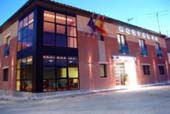Sea, sun, sand and sangria – the Spanish resort of Benidorm certainly offers all of these and plenty more besides. Situated in the Costa Blanca region of south-eastern Spain, Benidorm is, these days, the major destination in Europe for tourists looking for a seaside holiday, with in excess of four million visitors per year, this is a serious resort, the fabulous warm Benidorm weather attracting more and more visitors every year. Most visitors today would find it hard to believe that
Benidorm was just a tiny fishing village up until the 1950’s when a growing tourist industry would result in huge changes not just to Benidorm but also many other towns and villages throughout Spain. The history of Benidorm, of course, goes back much, much further, with evidence of settlements as long ago as 3000 BC.
Fragments of Punic and Roman ships have been discovered in the Bay of Benidorm and there are also remains of a Roman villa in the area. However, the recorded history of Benidorm starts during the Moorish Conquest, when the first genuine settlement was built by the Moors and Benidorm became a fishing community of some significance. Benidorm and the region was reconquered for the Christians by Jaime I of Aragon (Jaume I) in 1245 and in 1325 the town was awarded its first charter. The original Benidorm Castle was built at around this time and was constructed in the area of the old village. Although no evidence now remains of the castle it was, at the time, very important in defending Benidorm from frequent attacks by Barbary pirates.
An irrigation drain built in 1666 to supply water to the surrounding land brought some improvements to the area and by 1715 the population of Benidorm had risen to 216. 1740 saw the start of construction on the Parish Church of San Jaime and the population grew rapidly by 1794 had topped 2,700. Although agriculture contributed to Benidorm’s economic survival during these years, fishing remained the prime industry and Benidorm’s fishermen gained a reputation as tuna fishermen.
By 1857 the population had risen to 3,750 but dropped back once again in 1920 when an outbreak of phylloxera seriously damaged a thriving grape growing industry. At around the same time there were signs of an emerging tourism industry in the area aided by the building of a narrow gauge railway. A small but growing number of tourists headed for Benidorm from inland towns such as Madrid.
Disaster loomed for Benidorm in the early 1950’s as fish catches fell dramatically, however an increase in tourism and a plan drawn up by the town in 1956 for improvements in the town targeted at leisure and tourism, was well founded, it resulted in a huge growth in population, which further accelerated in 1967 on the opening of Alicante (El Altet) airport.
Modern day Benidorm is a successful holiday resort with numerous hotels and rental accommodation properties catering for holidaymakers of all ages, nationalities and tastes. There is lots to see and do in and around Benidorm, there are 2 superb beaches (Playa levante and Playa Poinente), some wonderful theme parks such as Terra Mitica, the Aqualandia Water Park and Mundomar Marine and Exotic Animal Park, whatever you are looking for Benidorm certainly delivers. Benidorm Map.
